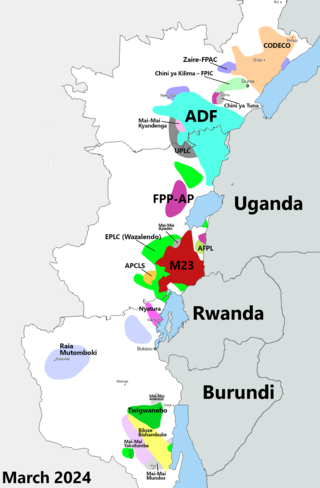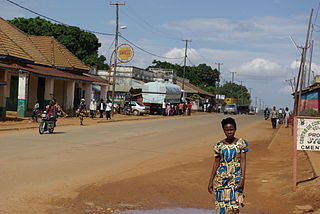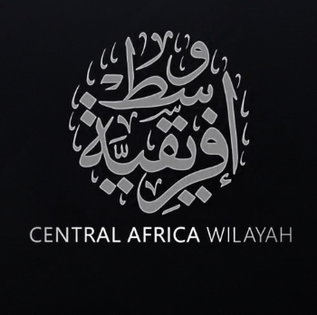
The Allied Democratic Forces is an Islamist rebel group in Uganda and the Democratic Republic of the Congo (DRC), considered a terrorist organisation by the Ugandan government. It was originally based in western Uganda but has expanded into the neighbouring DRC. Most Ugandan ADF fighters are Muslims from the Baganda and Basoga ethnic groups.

Bundibugyo District is a district in the Western Region of Uganda, bordering the Democratic Republic of the Congo (DRC). The town of Bundibugyo is where both the district headquarters and the Bwamba Kingdom seat are located. Before July 2010, the districts of Ntoroko and Bundibugyo were one. These districts are the only two in Uganda that lie west of the Rwenzori mountains. Bundibugyo was first named Semuliki district on separating it from the Greator Kabarole district alongside Rwenzori district (Kasese) in 1974.
Terrorism in Uganda primarily occurs in the north, where the Lord's Resistance Army, a militant Christian religious cult that seeks to overthrow the Ugandan government, has attacked villages and forcibly conscripted children into the organization since 1988. The al-Shabbab jihadist group has also staged attacks in the country.

The Kivu conflict is an umbrella term for a series of protracted armed conflicts in the North Kivu and South Kivu provinces in the eastern Democratic Republic of the Congo which have occurred since the end of the Second Congo War. Including neighboring Ituri province, there are more than 120 different armed groups active in the eastern Democratic Republic of Congo. Currently, some of the most active rebel groups include the Allied Democratic Forces, the Cooperative for the Development of the Congo, the March 23 Movement, and many local Mai Mai militias. In addition to rebel groups and the governmental FARDC troops, a number of national and international organizations have intervened militarily in the conflict, including the United Nations force known as MONUSCO, and an East African Community regional force.

The United Nations Force Intervention Brigade (FIB) is a military formation which constitutes part of the United Nations Organization Stabilization Mission in the Democratic Republic of the Congo (MONUSCO). It was authorized by the United Nations Security Council on 28 March 2013 through Resolution 2098. Although it is not the first instance in which the use of force was authorized by the UN, the Force Intervention Brigade is the first UN peacekeeping operation specifically tasked to carry out targeted offensive operations to "neutralize and disarm" groups considered a threat to state authority and civilian security. In this case, the main target was the M23 militia group, as well as other Congolese and foreign rebel groups. While such operations do not require the support of the Armed Forces of the Democratic Republic of the Congo (FARDC), the Force Intervention Brigade often acts in unison with the FARDC to disarm rebel groups.

The Allied Democratic Forces insurgency is an ongoing conflict waged by the Allied Democratic Forces in Uganda and the Democratic Republic of the Congo, against the governments of those two countries and the MONUSCO. The insurgency began in 1996, intensifying in 2013, resulting in hundreds of deaths. The ADF is known to currently control a number of hidden camps which are home to about 2,000 people; in these camps, the ADF operates as a proto-state with "an internal security service, a prison, health clinics, and an orphanage" as well as schools for boys and girls.

Lubero is a town in the North Kivu Province of the Democratic Republic of the Congo. It is the administrative center of the Lubero Territory. Following the surrender of the Mai-Mai fighters in 2021, construction of a new market began in 2022, involving the mayor, ex-soldiers, "young people at risk and the vulnerable women". As of March 2014, the population of Lubero is not publicly known.

The Katanga insurgency is an ongoing rebellion by a number of rebel groups in the Democratic Republic of the Congo, some of which aim for the creation of a separate state within Katanga. While the insurgency has been active in various forms since 1963, insurgent groups have recently redoubled their efforts after the 2011 jail break that freed Gédéon Kyungu Mutanga, who commanded the majority of the Katangese separatist groups until his surrender to Congolese authorities in October 2016.

On 14 August 2016, multiple assailants raided the district of Rwangoma in the city of Beni which is located in North Kivu of the Democratic Republic of Congo (DRC). The city is located in the popular Virunga National Park. At least 64 people were killed, as 64 bodies had been located during the search. Officials estimate the death toll to be from 75 to 101. An unknown number of people were injured. The Ugandan rebel group Allied Democratic Forces (ADF) were suspected to be behind to attack by the DRC. The incident is another in a series of massacres in Beni that have left over 700 people dead since October 2014.

The 2017 Semuliki attack was an attack carried out by elements of the Allied Democratic Forces on a United Nations Organization Stabilization Mission in the Democratic Republic of the Congo (MONUSCO) operating base in the Beni Territory, North Kivu region of the Democratic Republic of the Congo on December 7, 2017. The attack was highly coordinated and resulted in the deaths of fifteen U.N. peacekeeping personnel and wounds to 53 others making it the deadliest incident for the U.N. since the deaths of twenty-four Pakistani peacekeepers in an ambush in Somalia in 1993. The attack was among many of the latest flare-ups in violence in the North Kivu region which borders Uganda and Rwanda and one of the ADF's deadliest attacks in recent history. U.N. Secretary-General António Guterres labeled the attack, "the worst attack on UN peacekeepers in the organization's recent history."
Jamil Mukulu is a Ugandan militant leader and suspected war criminal who was the principal founder and former leader of the Allied Democratic Forces, an armed Islamist rebel group in Uganda and the Democratic Republic of the Congo. Mukulu was arrested in Tanzania in 2015 and is currently awaiting trial in Uganda for charges such as murder and crimes against humanity.

The Central Africa Province is an administrative division of the Islamic State (IS), a Salafi jihadist militant group and unrecognised quasi-state. As a result of a lack of information, the foundation date and territorial extent of the Central Africa Province are difficult to gauge, while the military strength and activities of the province's affiliates are disputed. According to pro-IS media and some other sources, the Central Africa Province has a presence in the Democratic Republic of the Congo as well as Mozambique. In September 2020, during the insurgency in Cabo Delgado, IS-CAP shifted its strategy from raiding to actually occupying territory, and declared the Mozambican town of Mocímboa da Praia its capital.
The 2020 Democratic Republic of the Congo attacks were a series of attacks which took place in 2020. The attacks were mostly carried out by the Allied Democratic Forces (ADF), a radical Islamist rebel group and the Cooperative for the Development of Congo (CODECO), an agricultural and religious group made up of ethnic Lendu people. The attacks left at least 1,316 people dead and 132 injured.

CODECO is a loose association of various Lendu militia groups operating within the Democratic Republic of the Congo. The name is an abbreviation of the group's lesser-known full name, the Cooperative for Development of the Congo, sometimes also styled the Congo Economic Development Cooperative.

In late March 2022, the March 23 Movement (M23) launched an offensive in North Kivu, clashing with the Armed Forces of the Democratic Republic of the Congo (FARDC) and MONUSCO. The fighting displaced hundreds of thousands of civilians and caused renewed tensions between the Democratic Republic of the Congo and Rwanda, as the latter was proved of supporting the rebel offensive.
Between August 5 and 7, 2022, suspected ADF forces attacked the villages of Kandoyi and Bandiboli, in Ituri Province, Democratic Republic of the Congo. During the attacks, ADF militiamen burned down houses and attacked residents, killing 10 people in Kandoyi and 5 others in Bandiboli. Fighting between Congolese forces, Mai-Mai, and other rebel groups occurred in the area at the time.
On the night on June 5, 2022, militants from Allied Democratic Forces (ADF) attacked the village of Bwanasura, in Otomabere, North Kivu, in the Democratic Republic of the Congo. The attack killed over twenty civilians, marking one of the deadliest attacks by the ADF in 2022.
During 8–9 March 2023, the Allied Democratic Forces (ADF) carried out a massacre in the village of Mukondi in North Kivu in the Democratic Republic of the Congo.
Between August 25 and 30, 2022, fighters of the Allied Democratic Forces attacked six villages in North Kivu, Democratic Republic of the Congo, killing over fifty-four people.
Between the night of April 3–4, 2022, Allied Democratic Forces jihadists attacked the village of Masambo, North Kivu, Democratic Republic of the Congo, killing 21 people.











